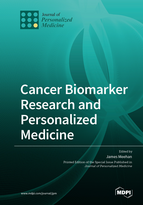Cancer Biomarker Research and Personalized Medicine
A special issue of Journal of Personalized Medicine (ISSN 2075-4426).
Deadline for manuscript submissions: closed (15 January 2022) | Viewed by 69382
Special Issue Editor
Interests: personalized medicine; prostate cancer; breast cancer; cancer cell biology; cancer biomarkers
Special Issues, Collections and Topics in MDPI journals
Special Issue Information
Dear colleagues,
Treating individual patients based on specific factors, such as biomarkers, is what differentiates personalized medicine from standard treatment regimens. Although personalized medicine can be applied to almost any branch of medicine, it is perhaps most easily applied to the field of oncology. Cancer is a heterogeneous disease, meaning that even though patients may be histologically diagnosed with the same cancer type, their tumors may have different molecular characteristics, genetic mutations or tumor microenvironments that can influence prognosis or treatment response. Through biomarkers, patients could be separated into cohorts with respect to distinctions in disease predisposition, prognosis, and expected response rates to different treatments. Improved outcomes can therefore be made using biomarkers to identify patients that have a greater likelihood of achieving a benefit from certain treatments, while also distinguishing those that require more aggressive treatment strategies.
As such, there is currently a major drive in oncology to achieve personalized cancer medicine through the identification and use of disease-specific biomarkers. These biomarkers include genes, intracellular or secreted proteins, circulating tumor cells, exosomes, and DNA. This Special Issue aims to describe current developments in biomarker research, outlining the latest advances in tissue- and blood/urine-based biomarker research.
Dr. James Meehan
Guest Editor
Manuscript Submission Information
Manuscripts should be submitted online at www.mdpi.com by registering and logging in to this website. Once you are registered, click here to go to the submission form. Manuscripts can be submitted until the deadline. All submissions that pass pre-check are peer-reviewed. Accepted papers will be published continuously in the journal (as soon as accepted) and will be listed together on the special issue website. Research articles, review articles as well as short communications are invited. For planned papers, a title and short abstract (about 100 words) can be sent to the Editorial Office for announcement on this website.
Submitted manuscripts should not have been published previously, nor be under consideration for publication elsewhere (except conference proceedings papers). All manuscripts are thoroughly refereed through a single-blind peer-review process. A guide for authors and other relevant information for submission of manuscripts is available on the Instructions for Authors page. Journal of Personalized Medicine is an international peer-reviewed open access monthly journal published by MDPI.
Please visit the Instructions for Authors page before submitting a manuscript. The Article Processing Charge (APC) for publication in this open access journal is 2600 CHF (Swiss Francs). Submitted papers should be well formatted and use good English. Authors may use MDPI's English editing service prior to publication or during author revisions.
Keywords
- tissue-based biomarker
- blood-based biomarker
- urine-based biomarker
- cancer
- precision medicine
- personalized medicine







